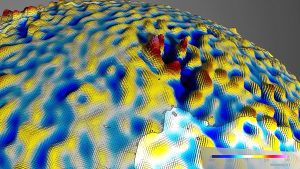
A map of the lithospheric magnetic field shows detailed variations caused by geological structures in Earth’s crust. One of these anomalies occurs in Central African Republic, centered on the city of Bangui, where the magnetic field is significantly sharper and stronger. The cause for this anomaly is unknown, but some scientists speculate that it may be the result of a meteorite impact more than 540 million years ago. (Credit: ESA/DTU Space/DLR)
Earth’s magnetic field is like a huge cocoon, protecting the planet from cosmic radiation and charged particles found in solar wind. European Space Agency (ESA) Swarm satellites are recording details about one of the most difficult to observe layers of Earth’s magnetic field—as well as the magnetic history imprinted on Earth’s crust.
Most of Earth’s magnetic field is generated by the movement of molten iron in the outer core at depths greater than 3,000 kilometers. The remaining 6 percent of the field is partly due to electrical currents in space surrounding Earth, and partly due to magnetized rocks in the upper lithosphere: the rigid outer part of Earth, consisting of the crust and upper mantle.
Although this “lithospheric magnetic field” is very weak and difficult to detect from space, the Swarm trio can map its magnetic signals. After three years of collecting data, the highest-resolution map of this field from space has been released.
“By combining Swarm measurements with historical data from the German CHAMP satellite, and using a new modeling technique, it was possible to extract the tiny magnetic signals of crustal magnetization,” explained Nils Olsen from the Technical University of Denmark, one of the scientists behind the new map.
The magnetic field is in a permanent state of flux. Magnetic north wanders—every few hundred-thousand years the polarity flips, so a compass would point south instead of north. When new crust is generated through volcanic activity, mainly along the ocean floor, iron-rich minerals in the solidifying magma are oriented toward magnetic north, thus capturing a “snapshot” of the magnetic field when the rocks cooled. Because magnetic poles flip back and forth, the solidified minerals form “stripes” on the seafloor and provide a record of Earth’s magnetic history.
The latest map from Swarm provides an unprecedented global view of the magnetic stripes associated with plate tectonics reflected in the mid-oceanic ridges in the oceans.
“These magnetic stripes are evidence of pole reversals, and analyzing the magnetic imprints of the ocean floor allows the reconstruction of past core field changes,” said Dhananjay Ravat from the University of Kentucky. “The new map defines magnetic field features down to about 250 kilometers, and will help investigate geology and temperatures in Earth’s lithosphere.”